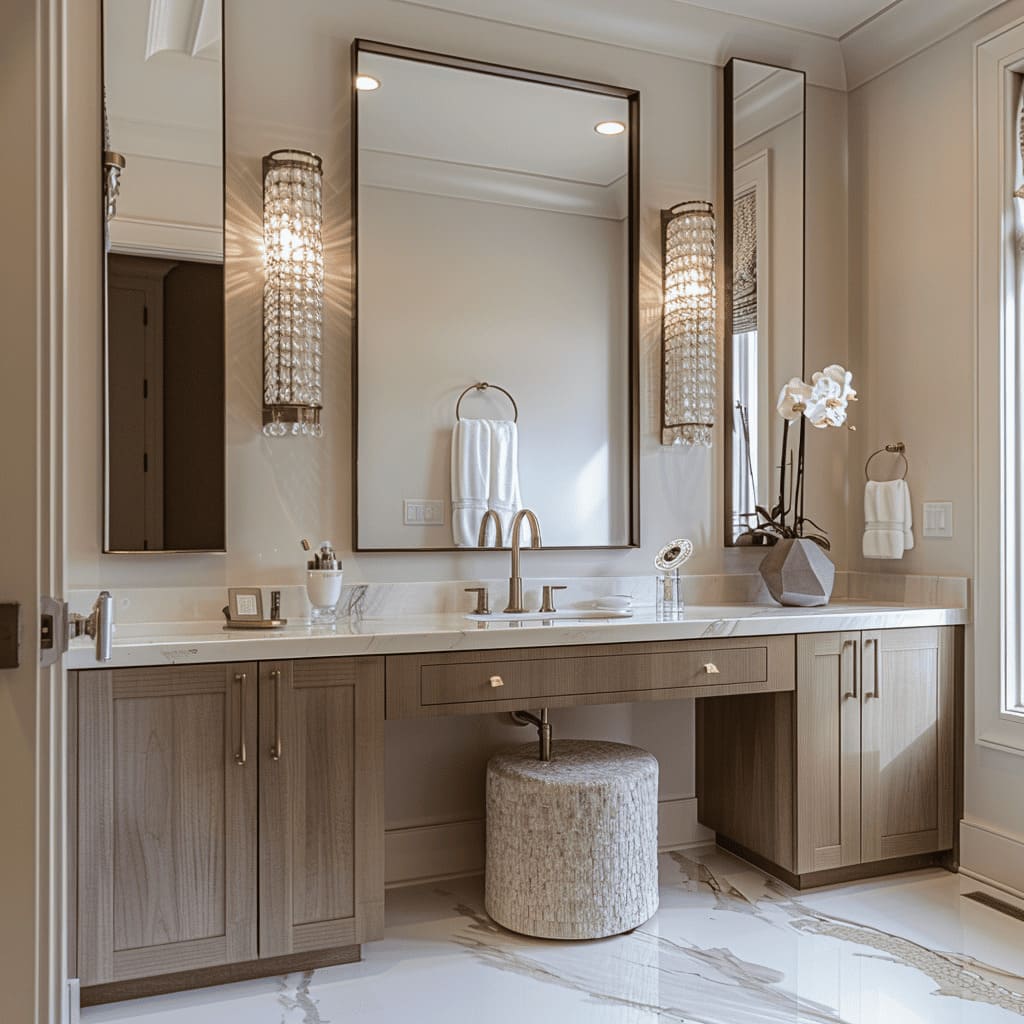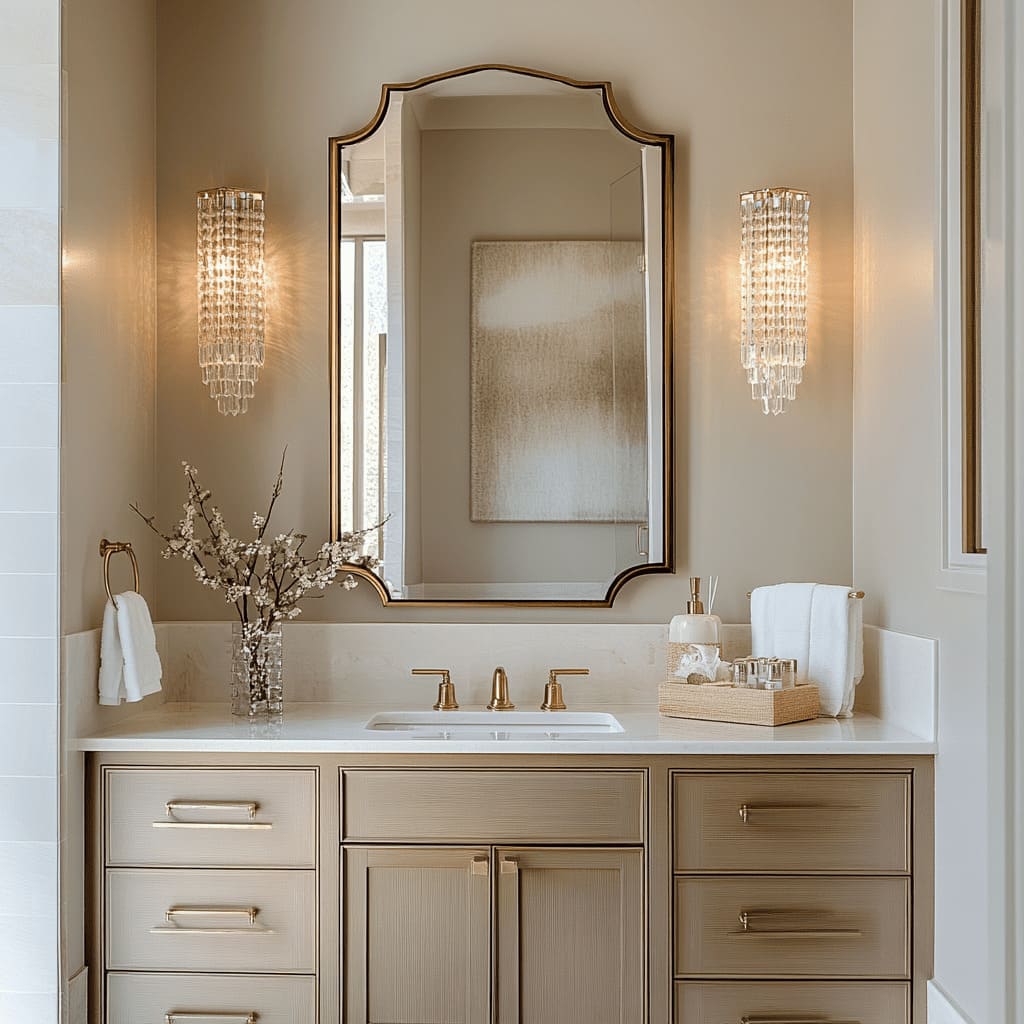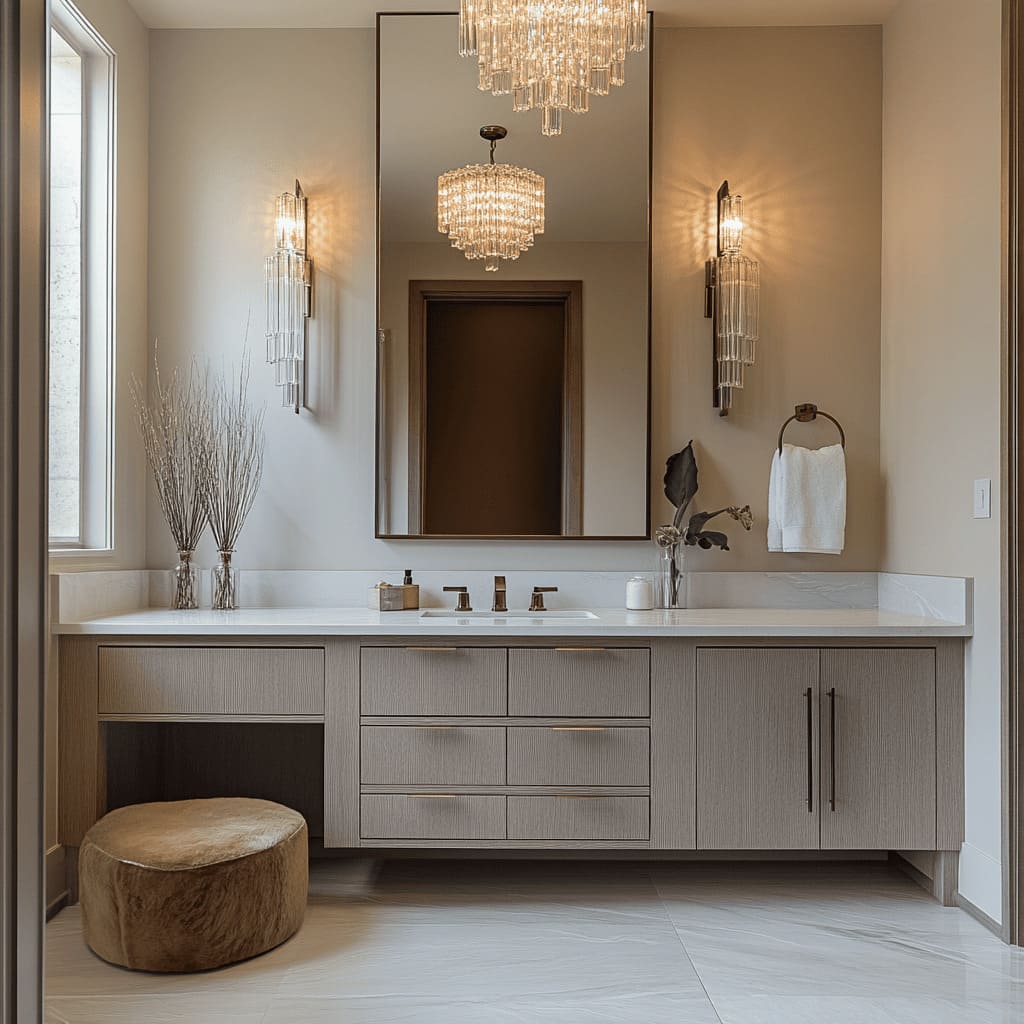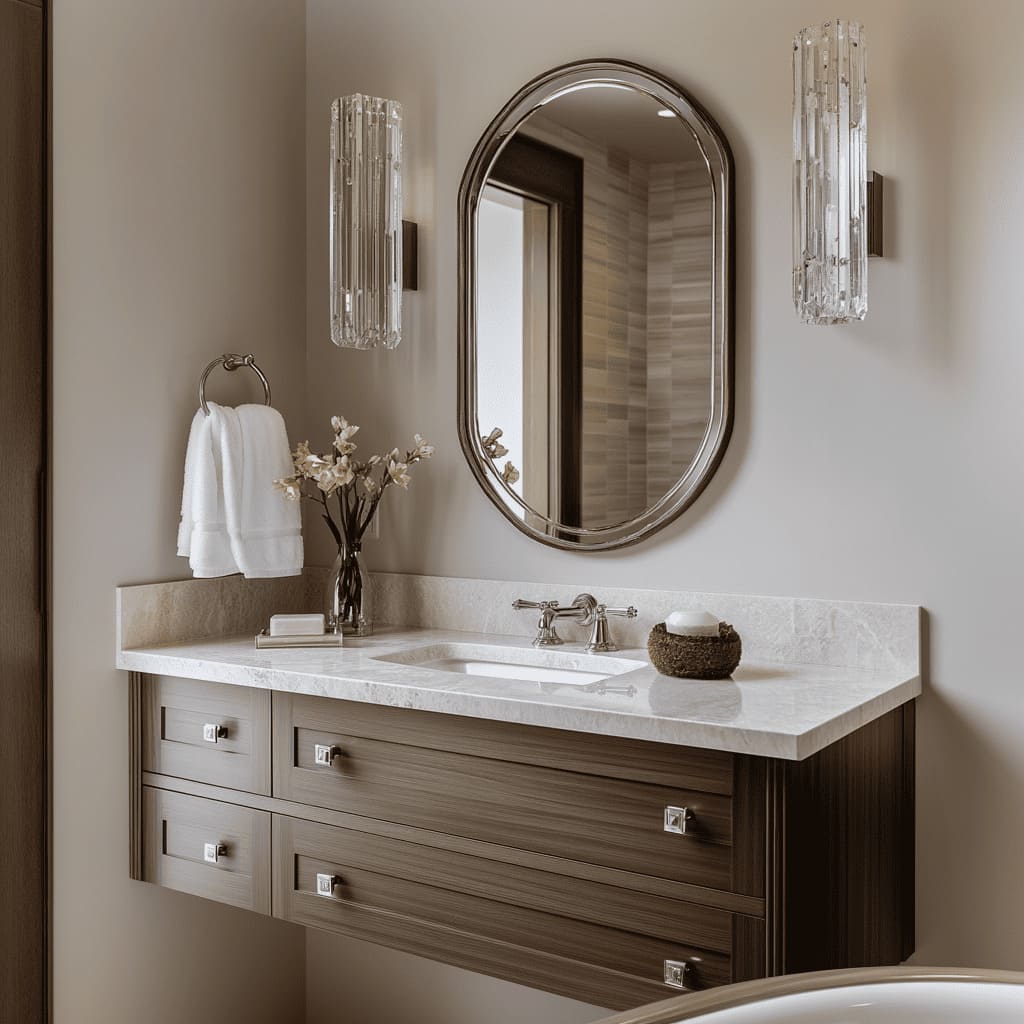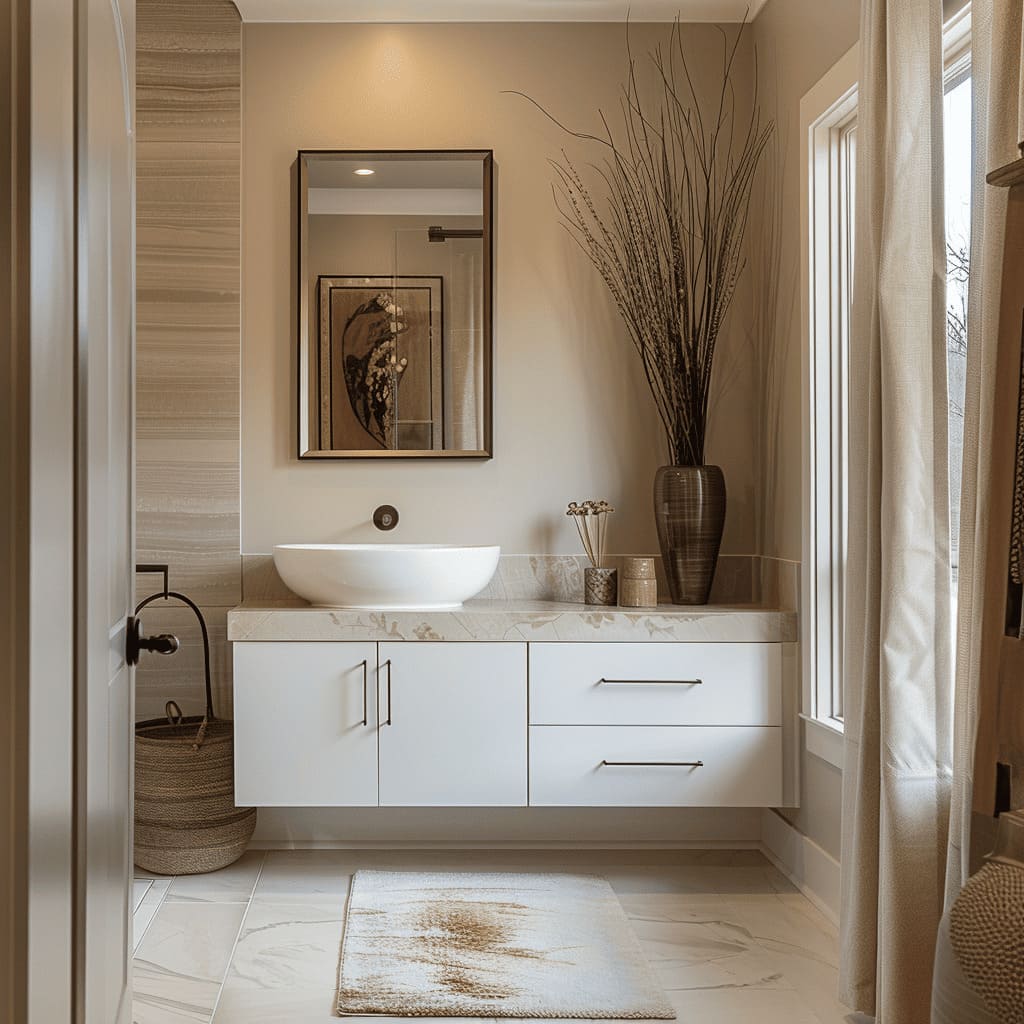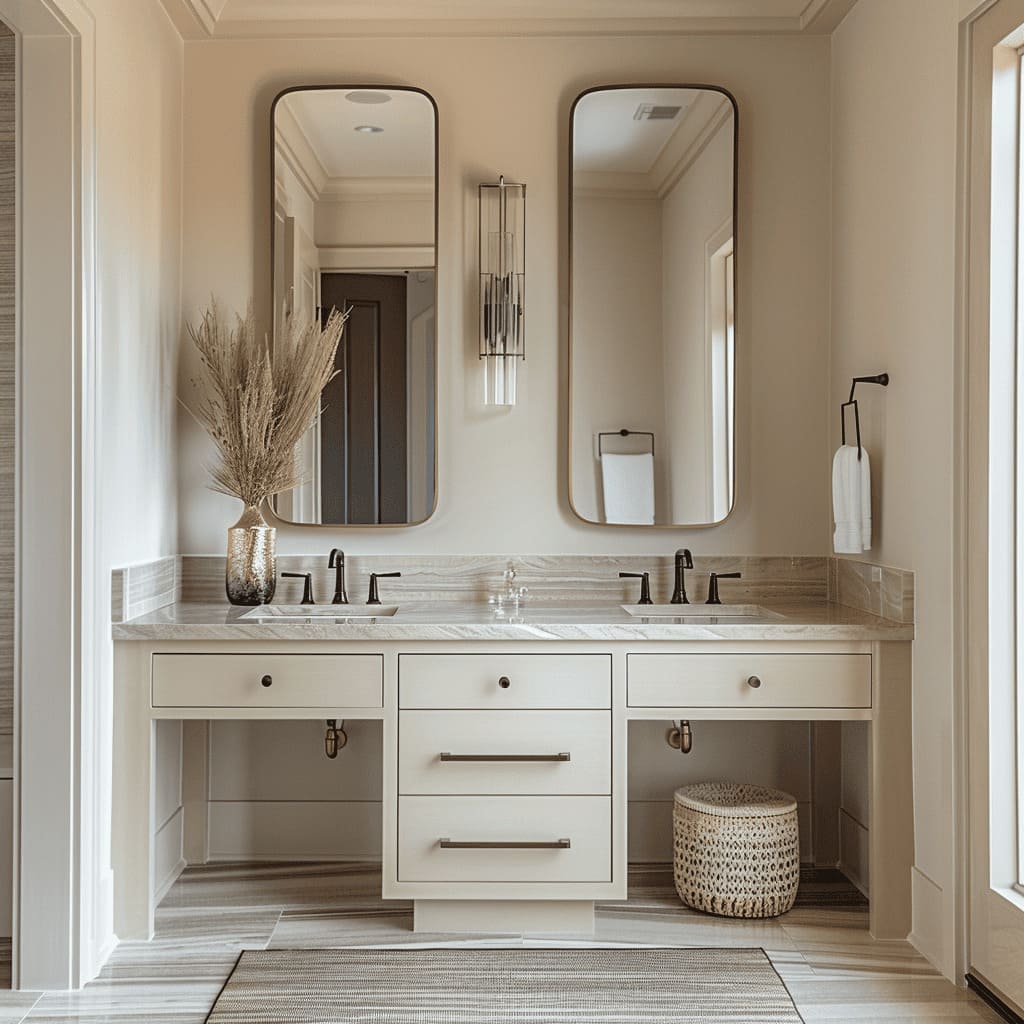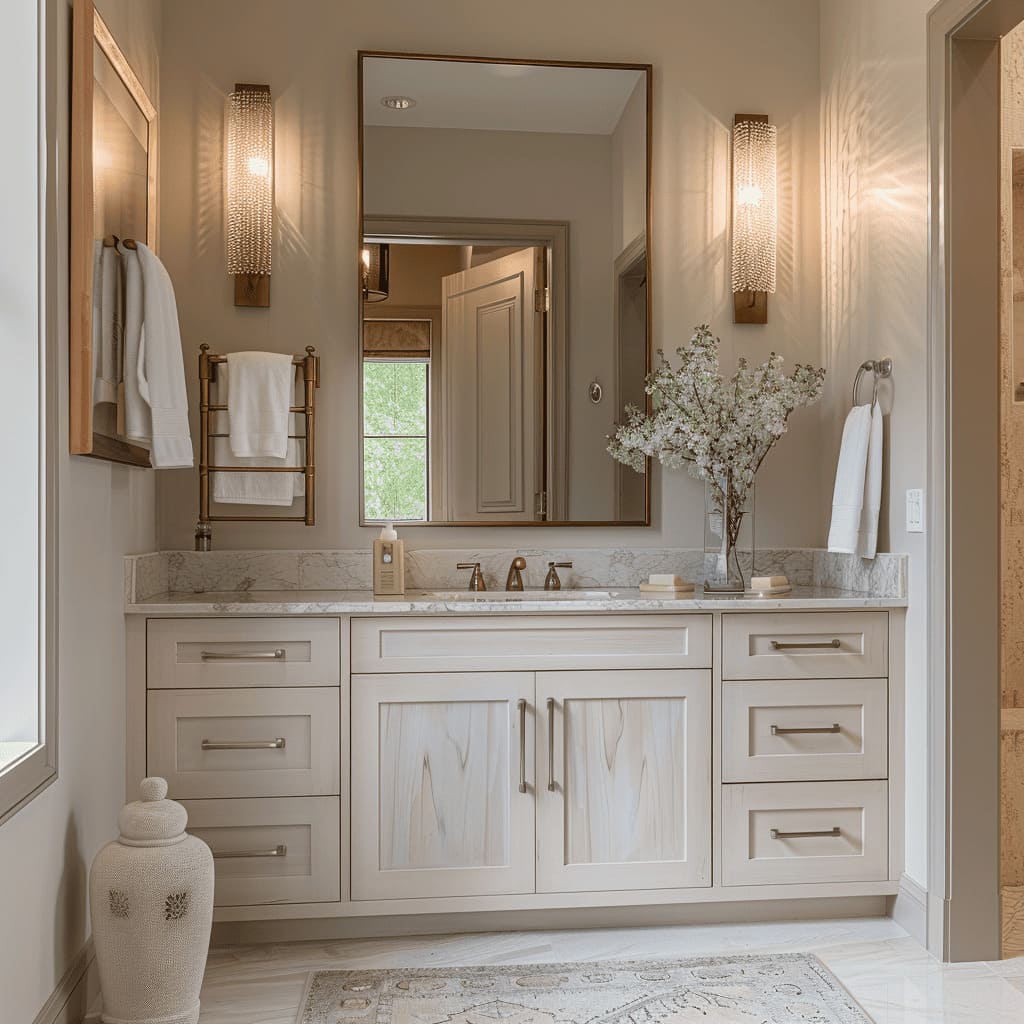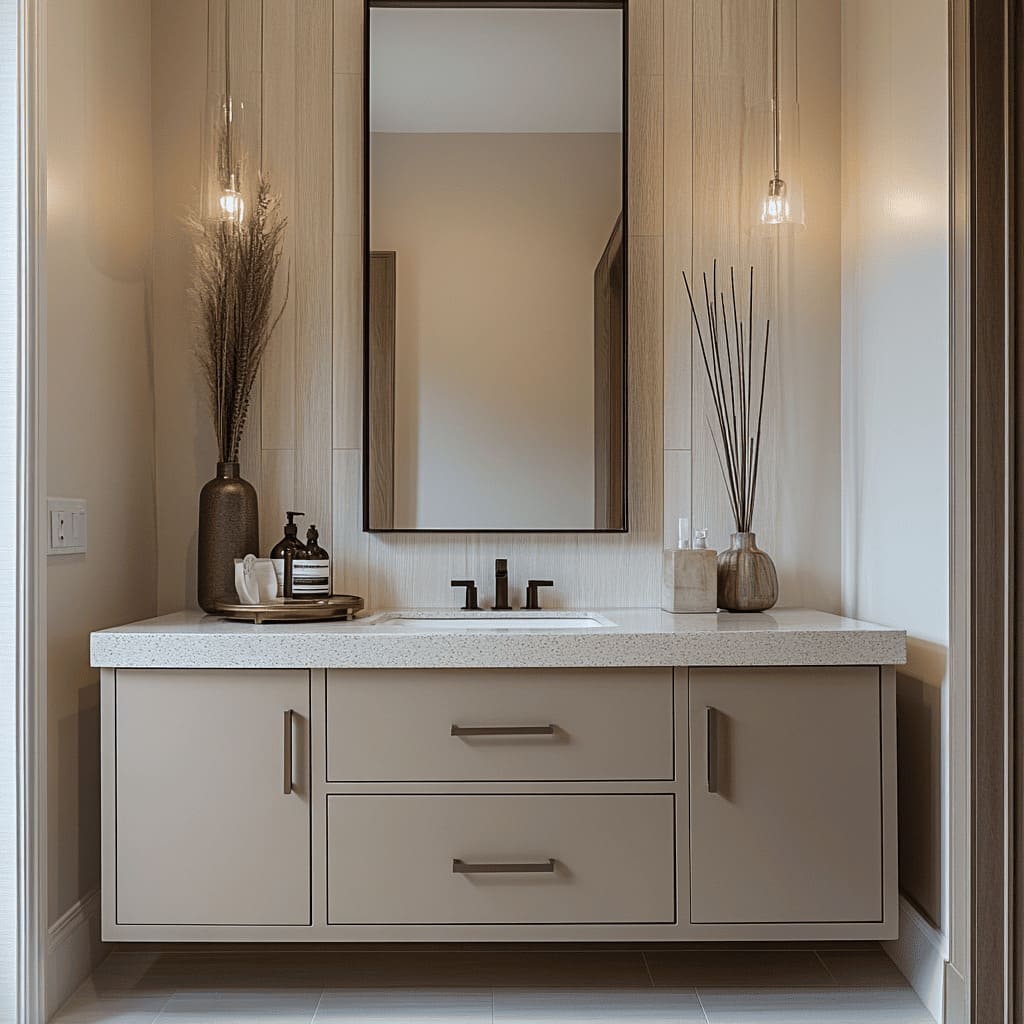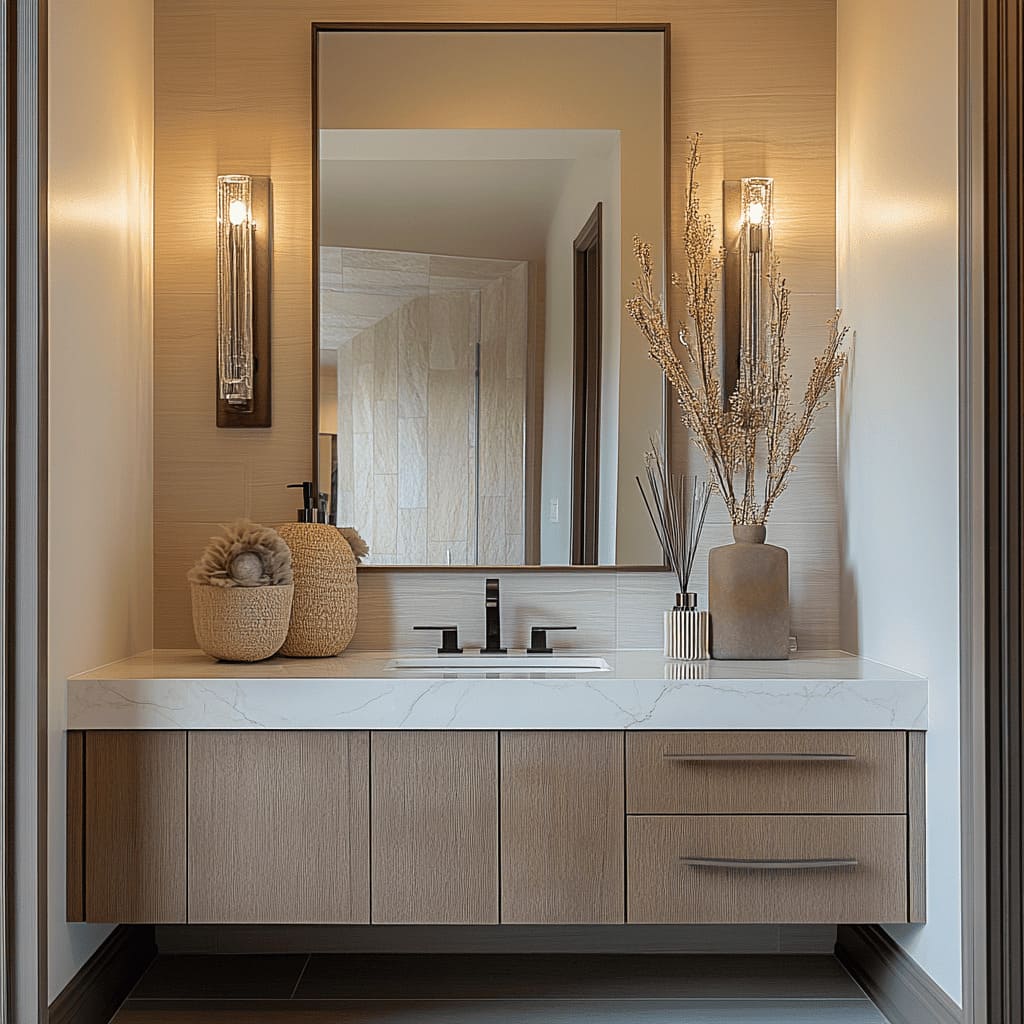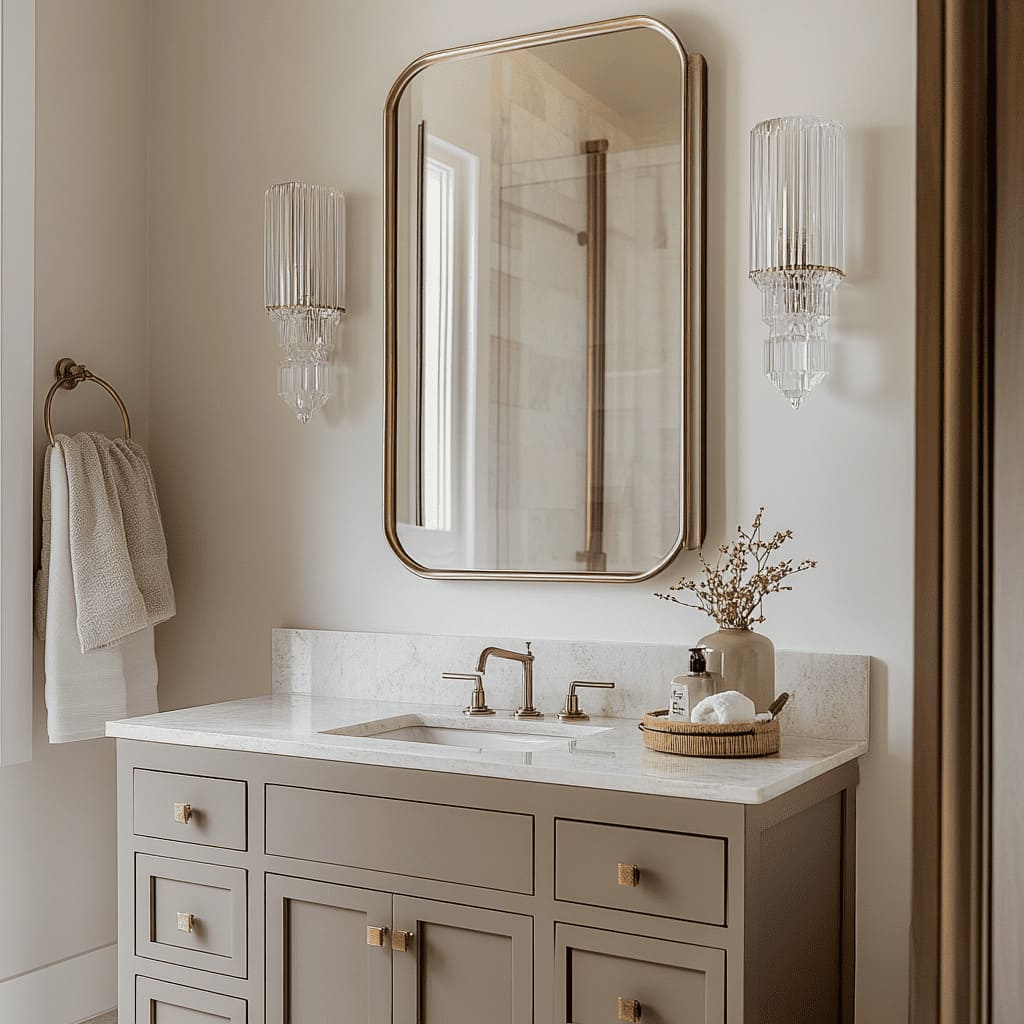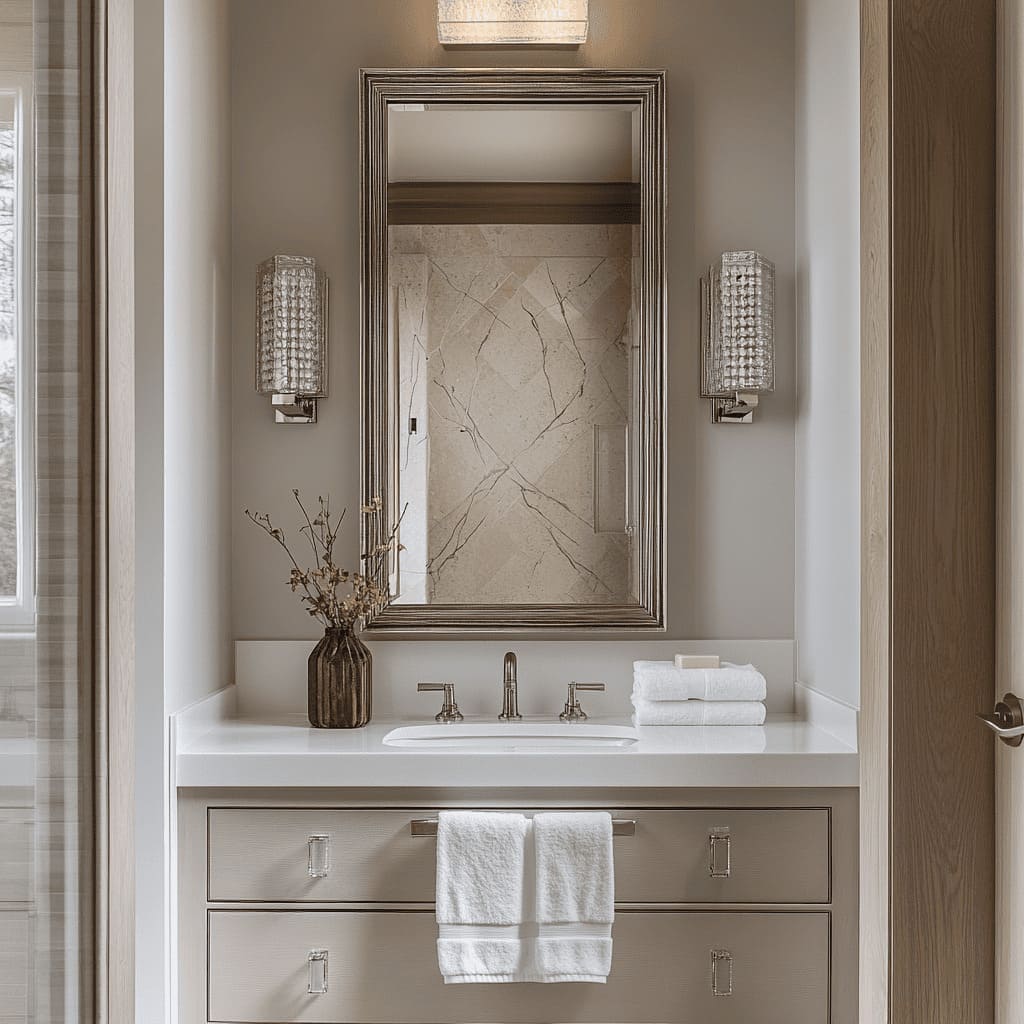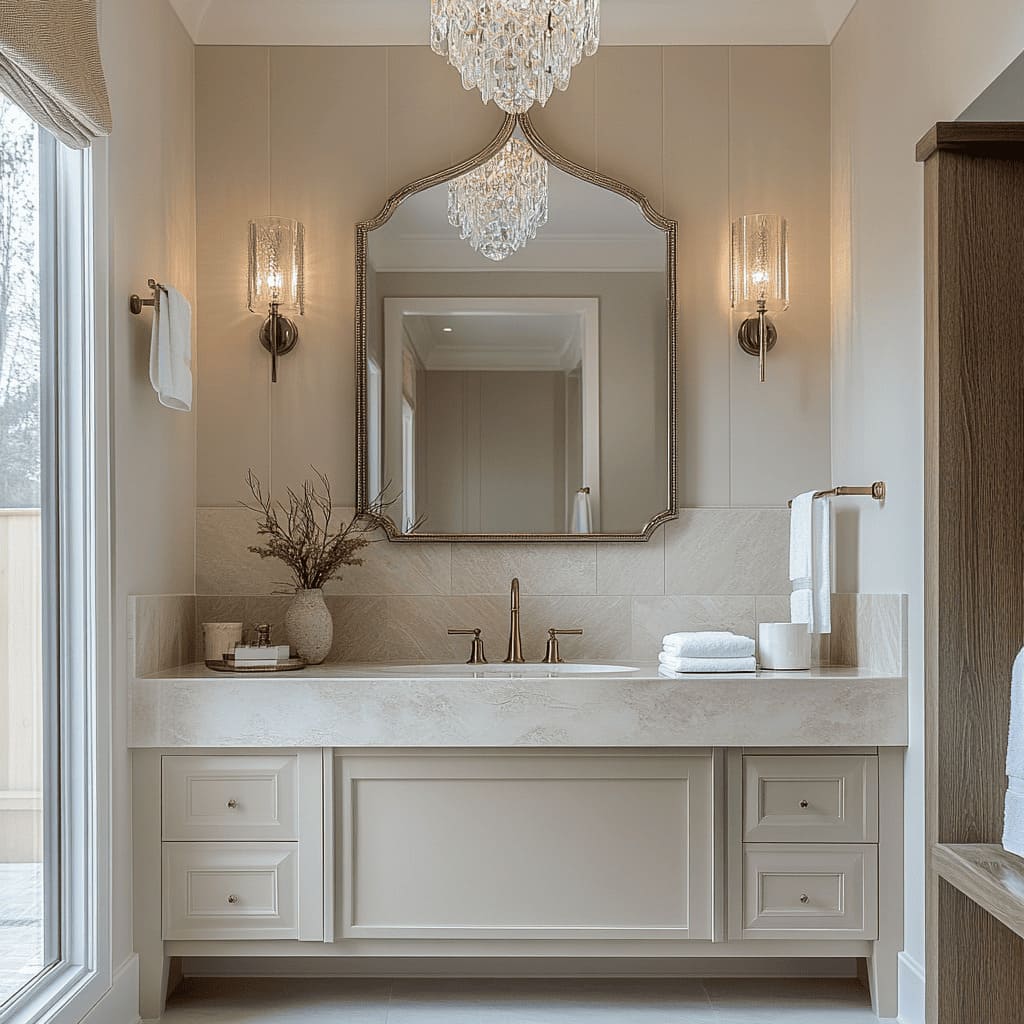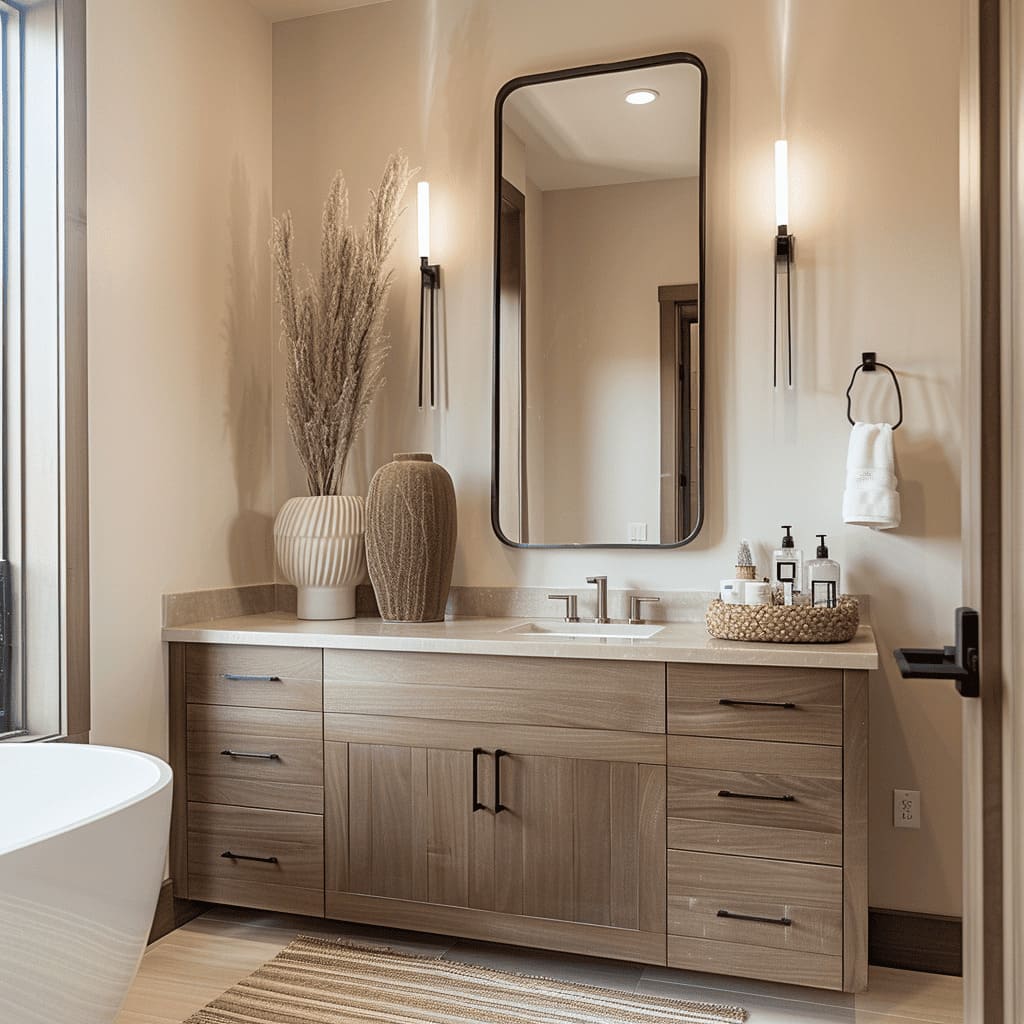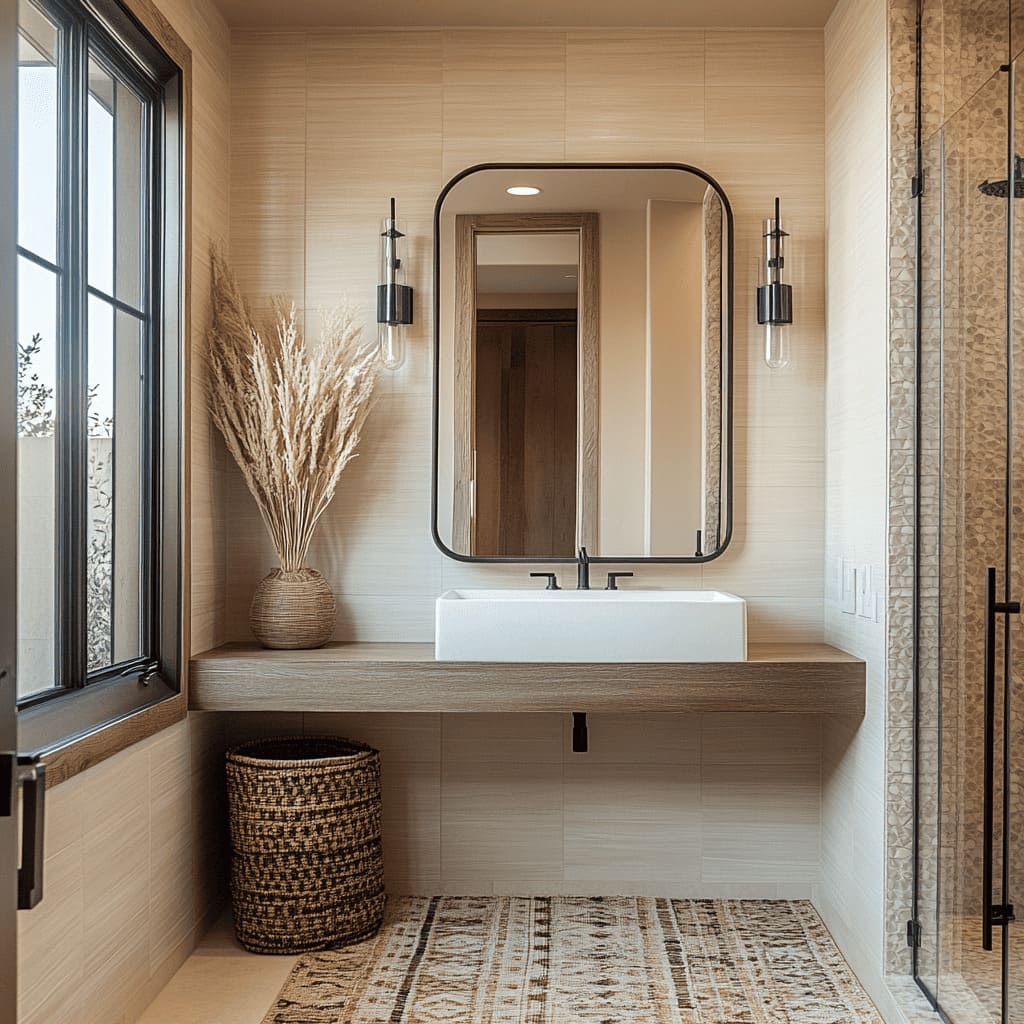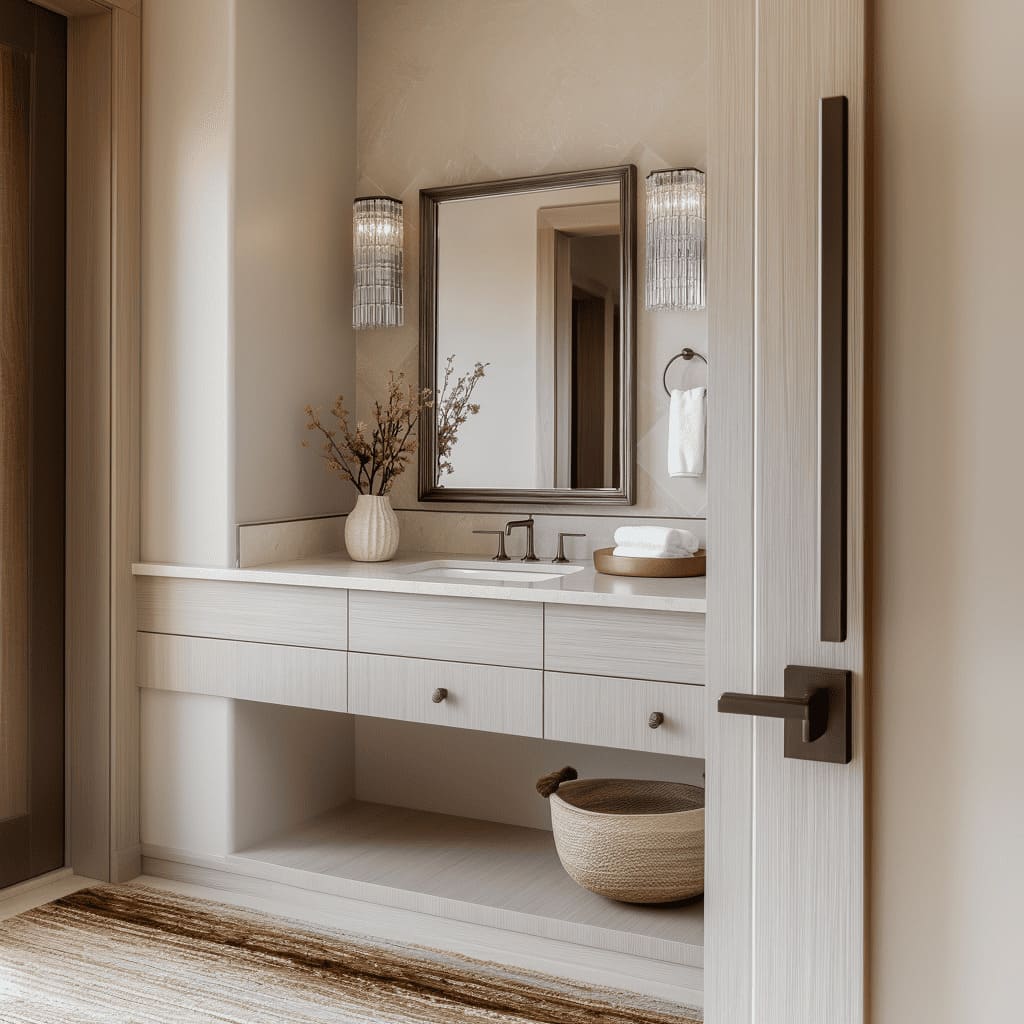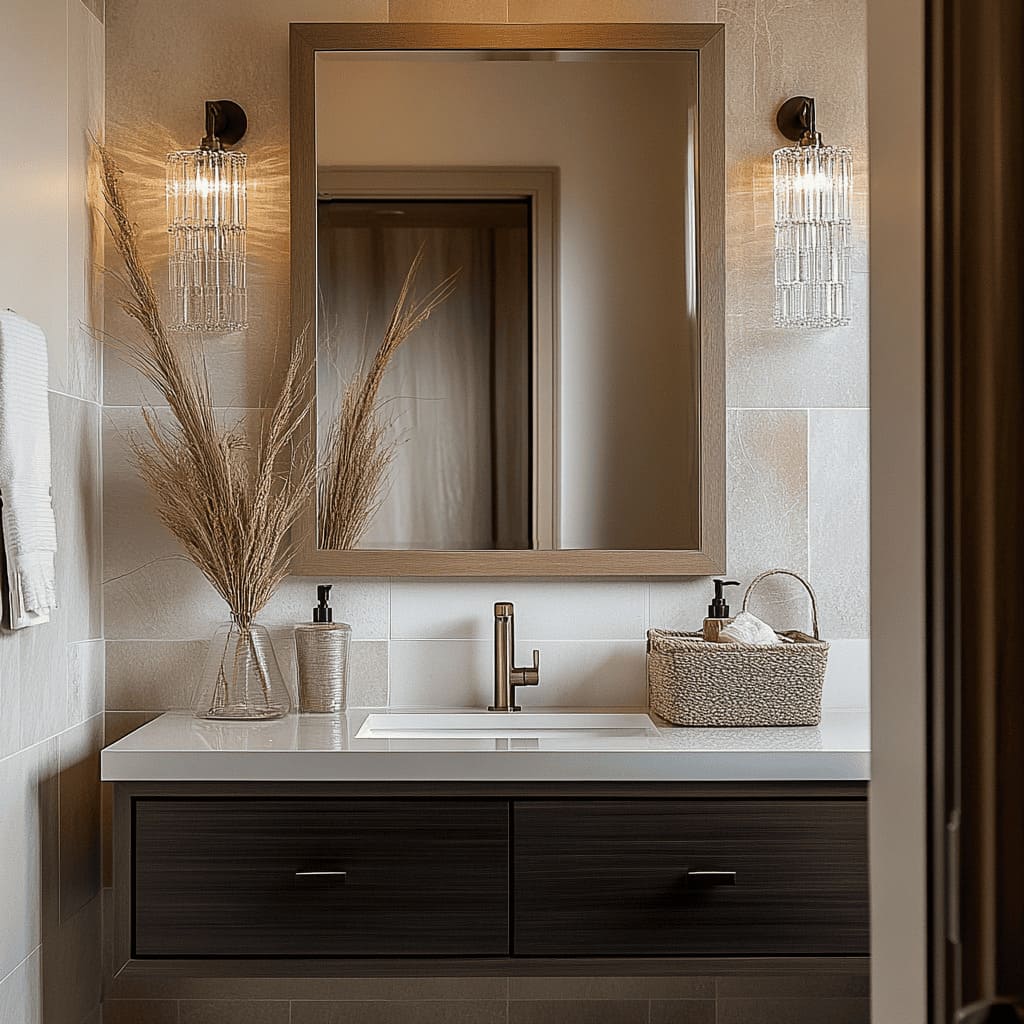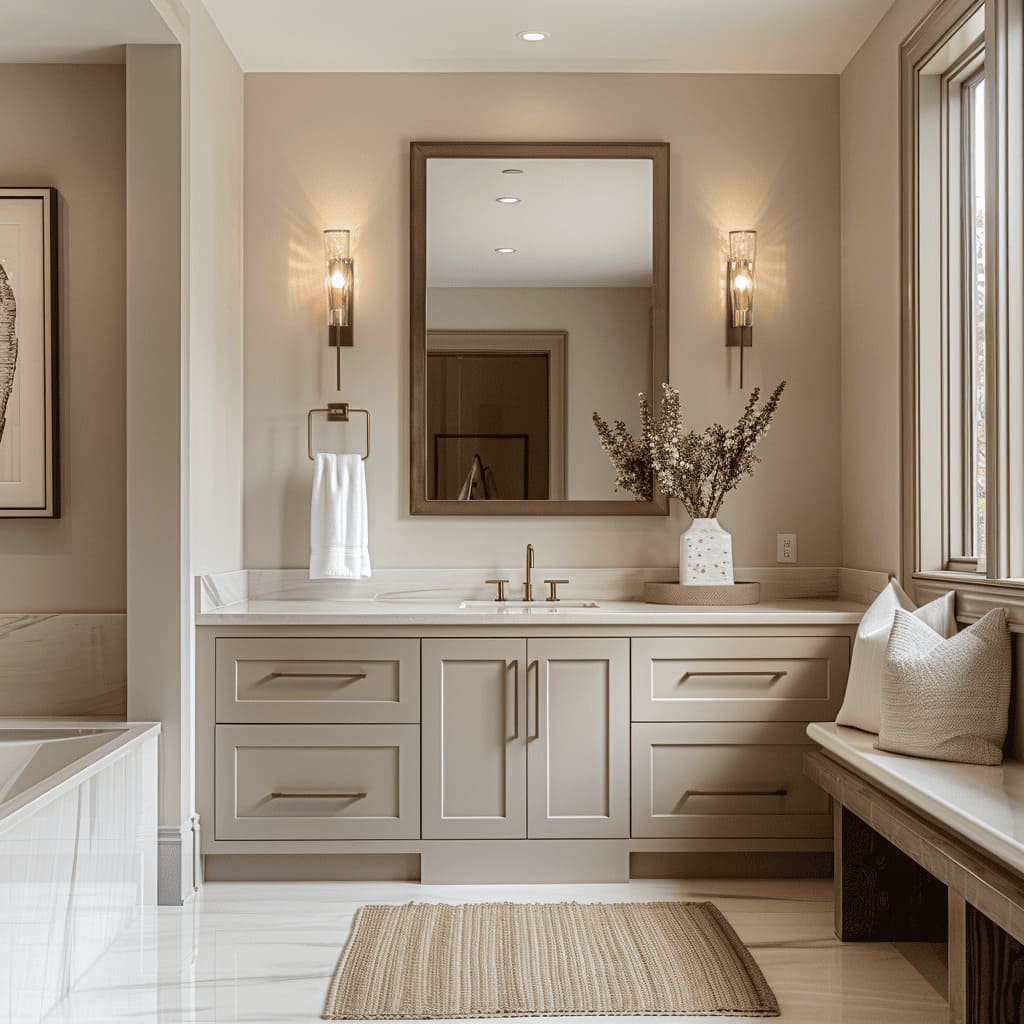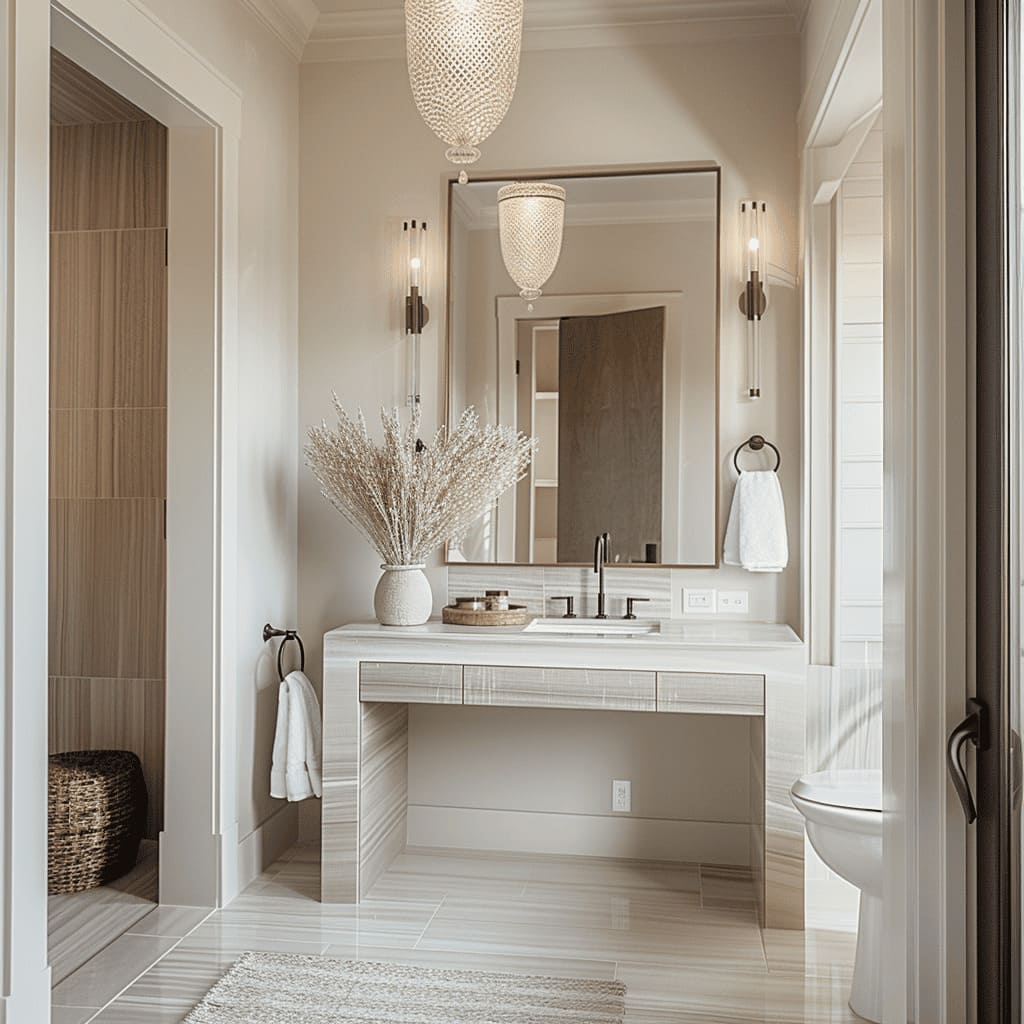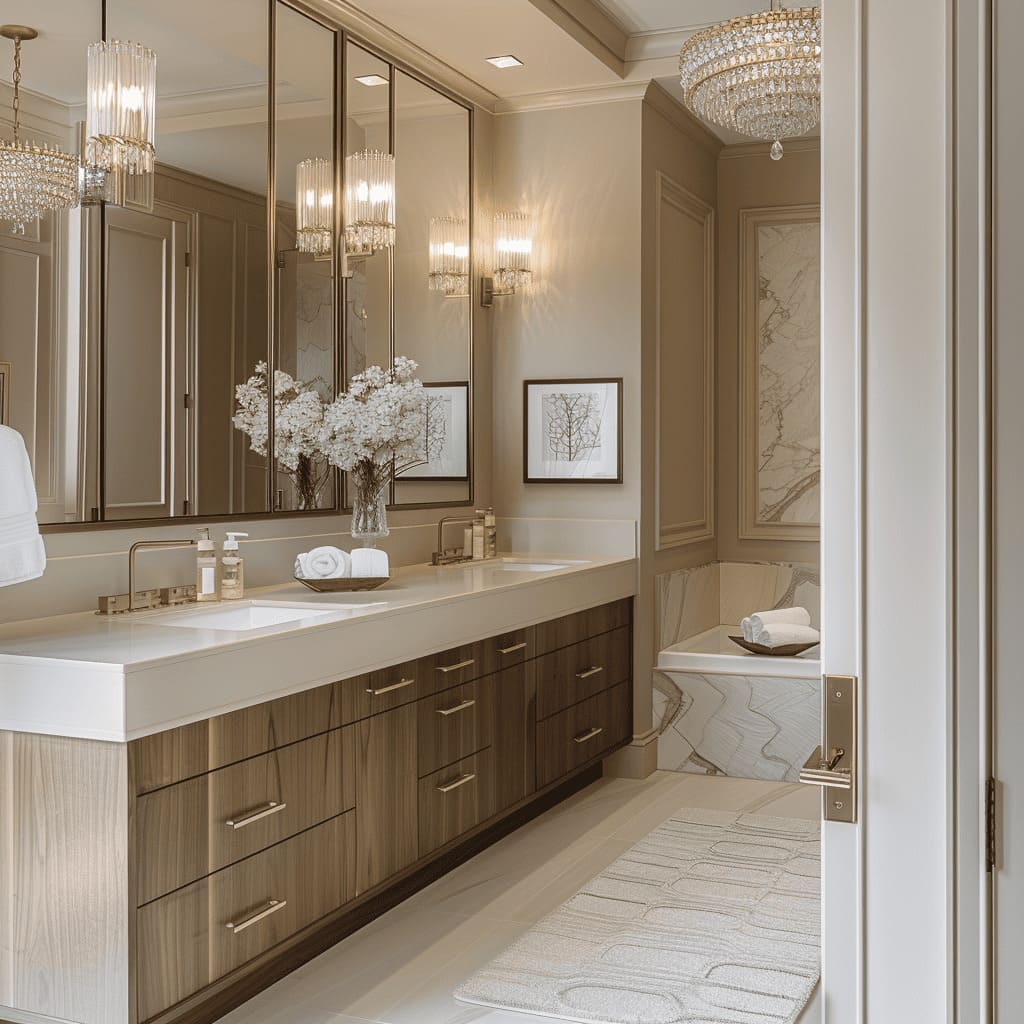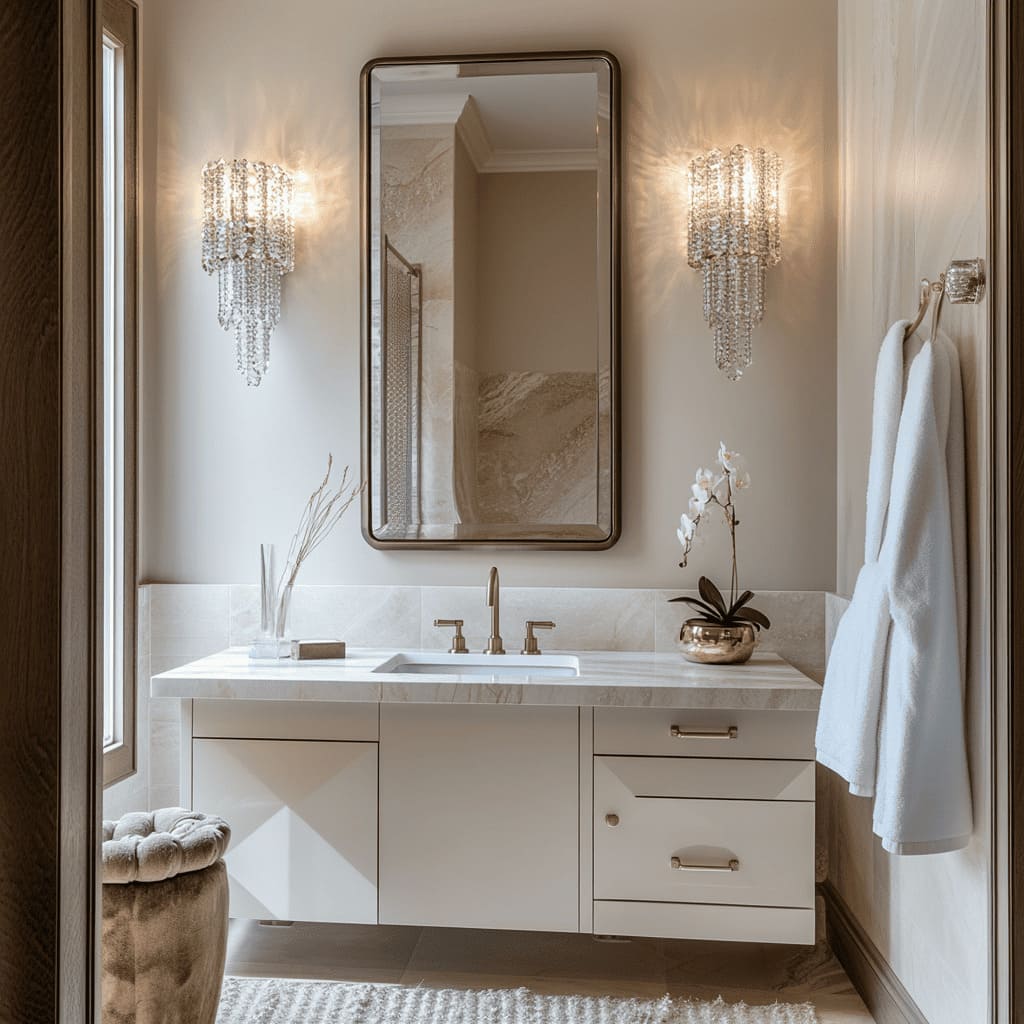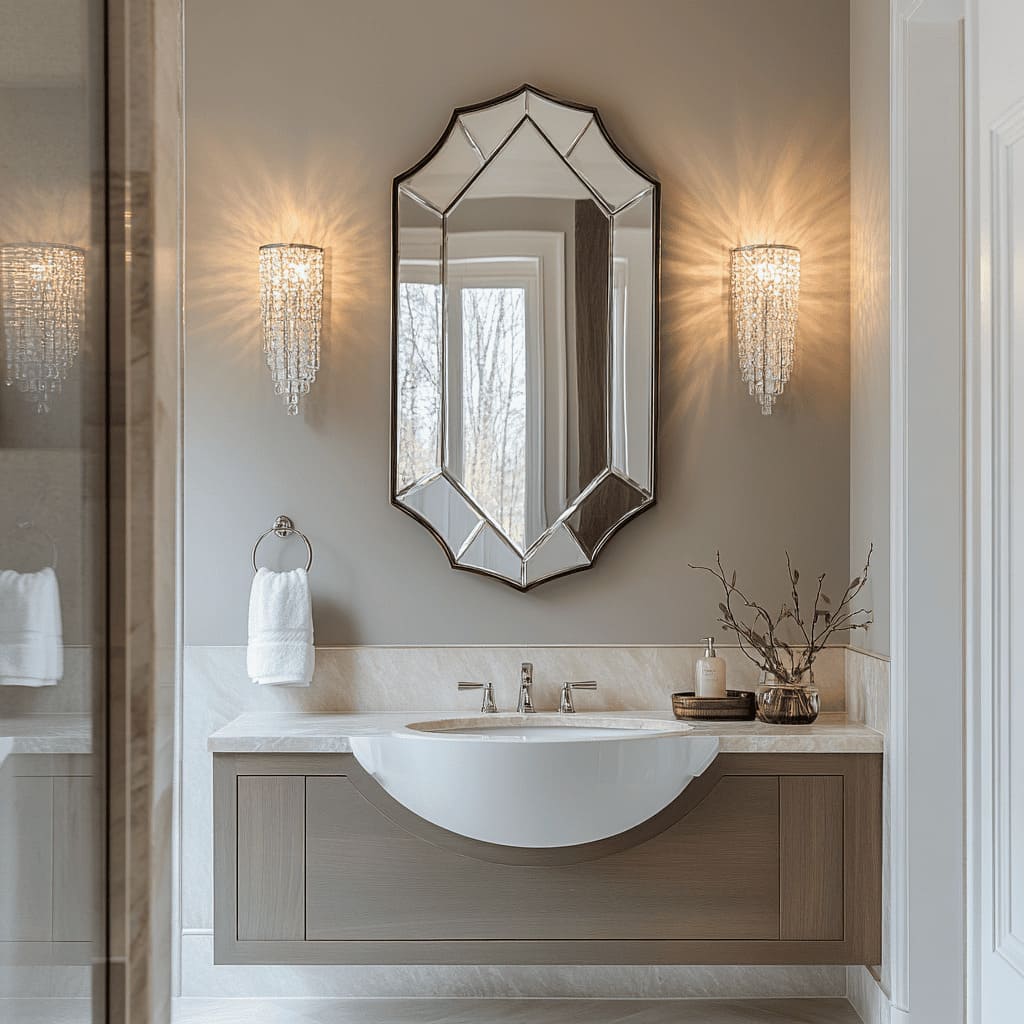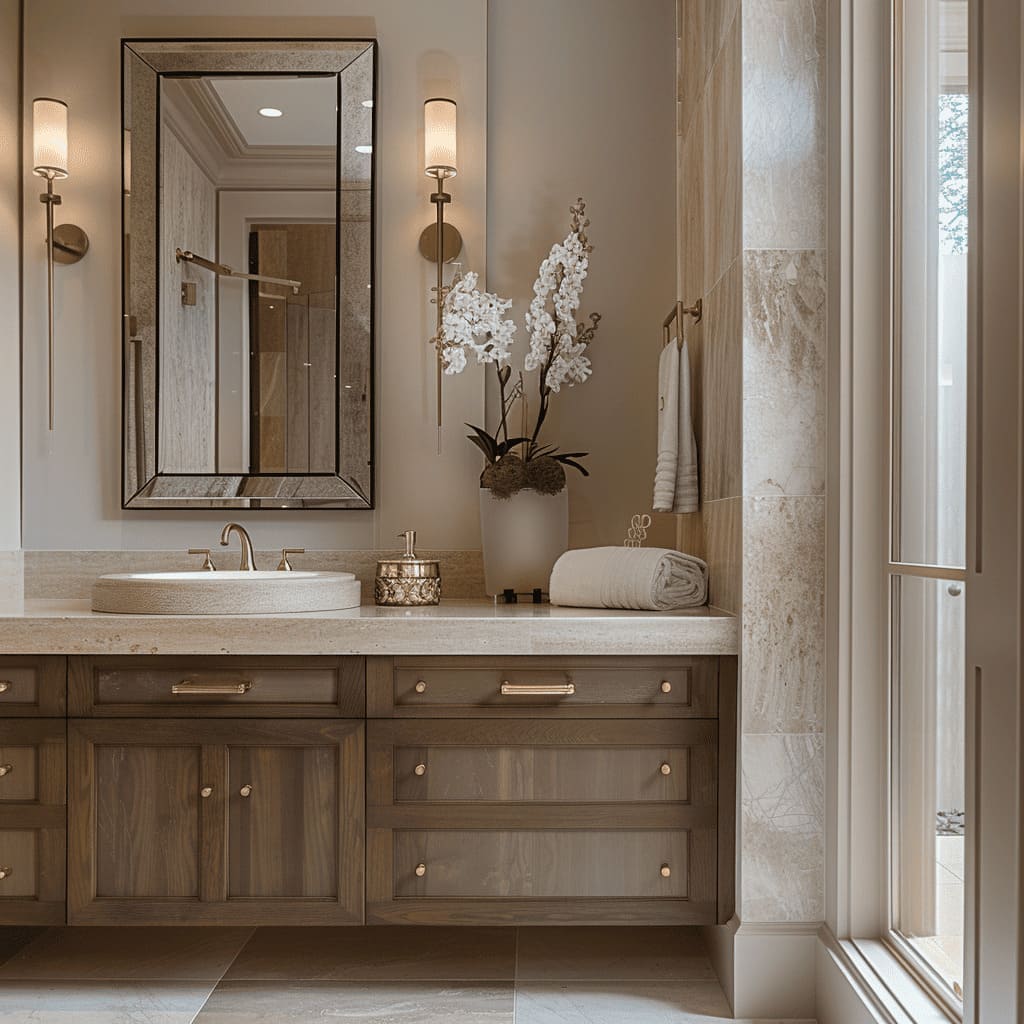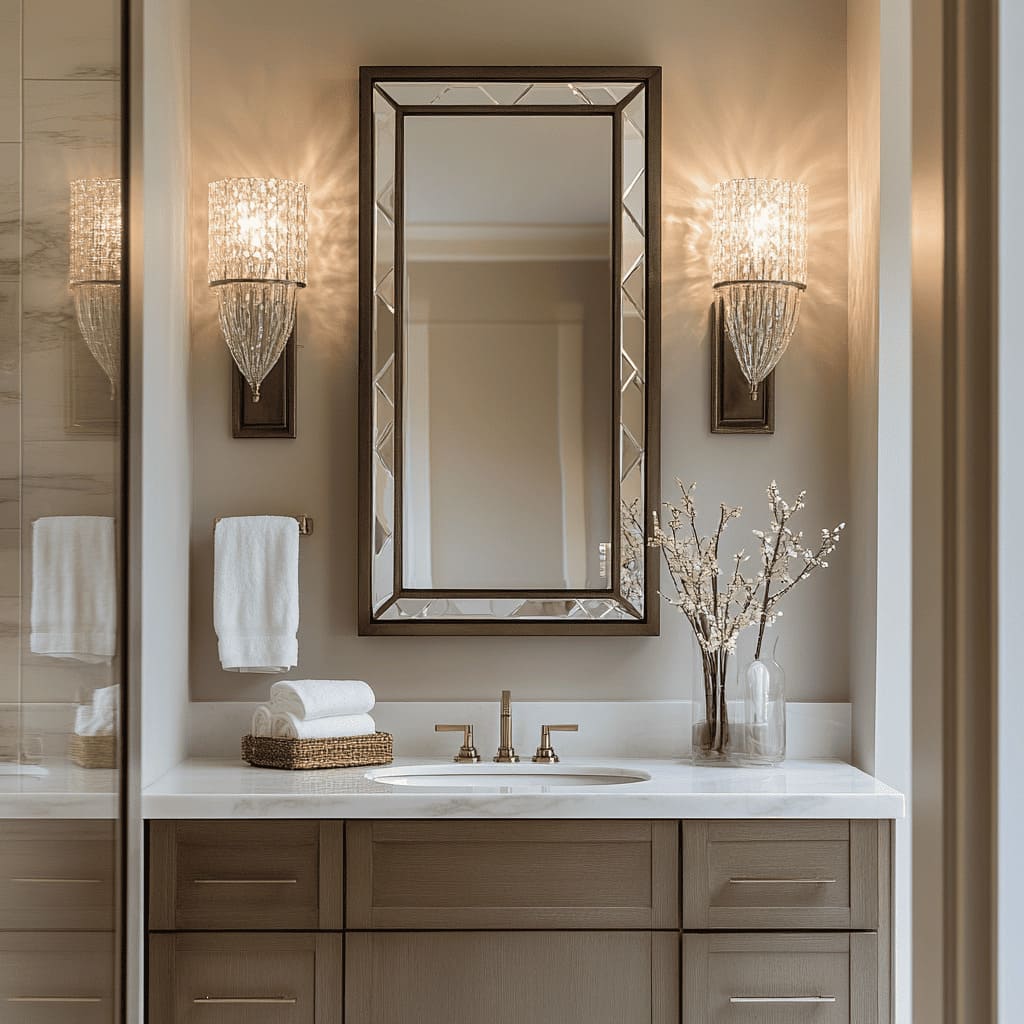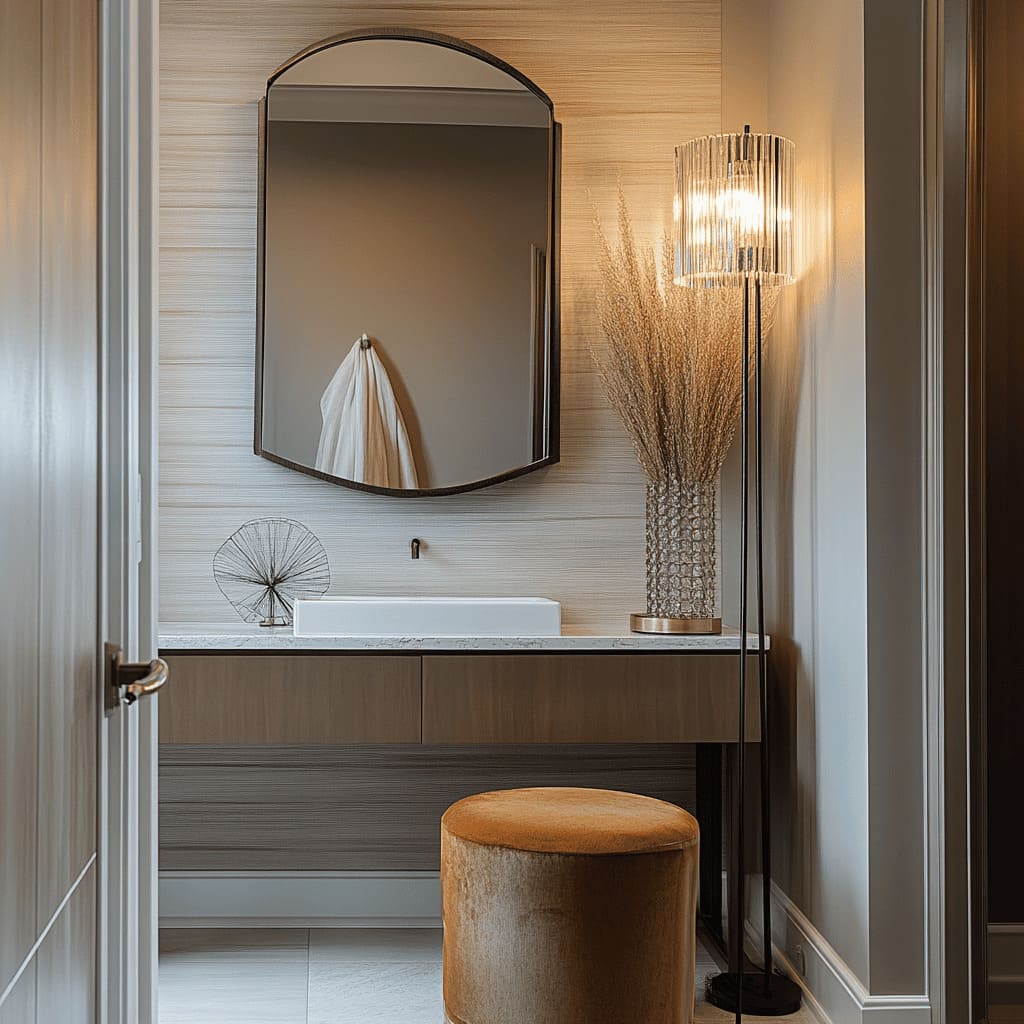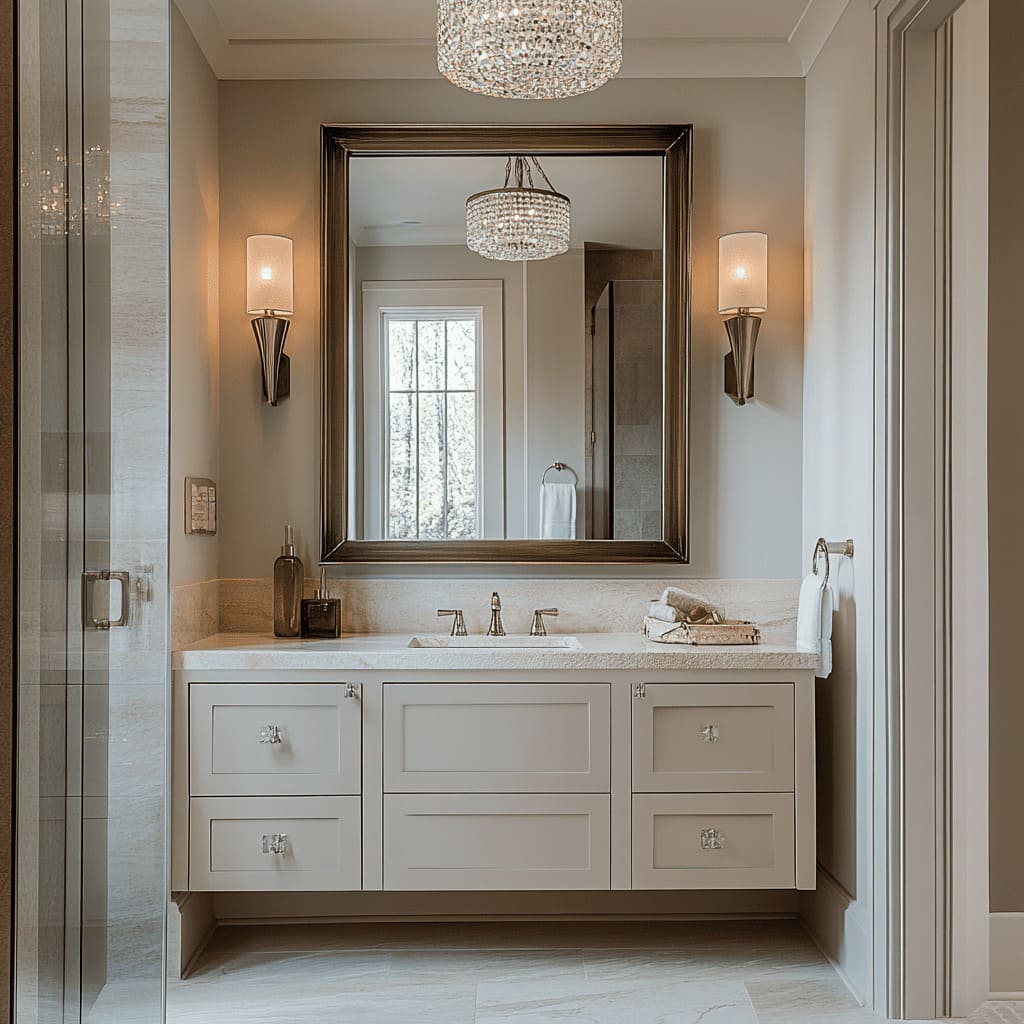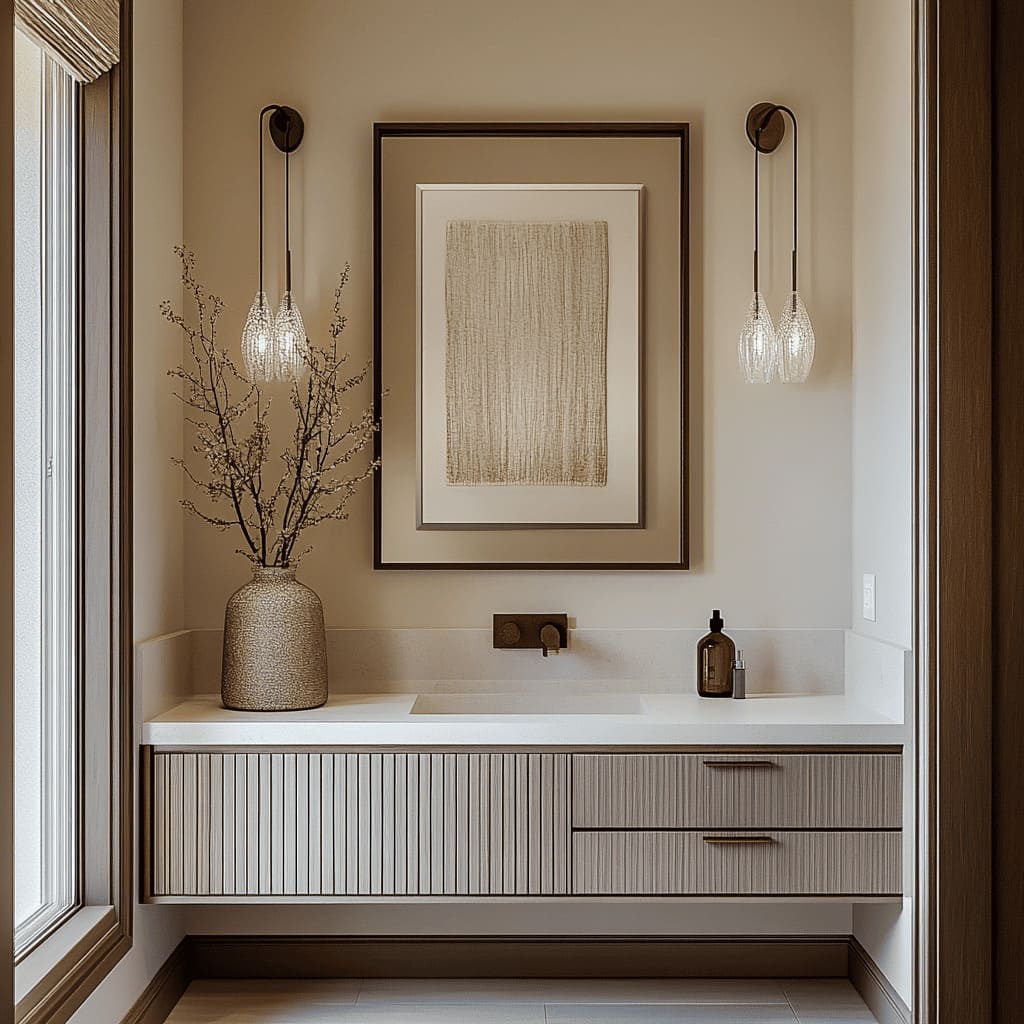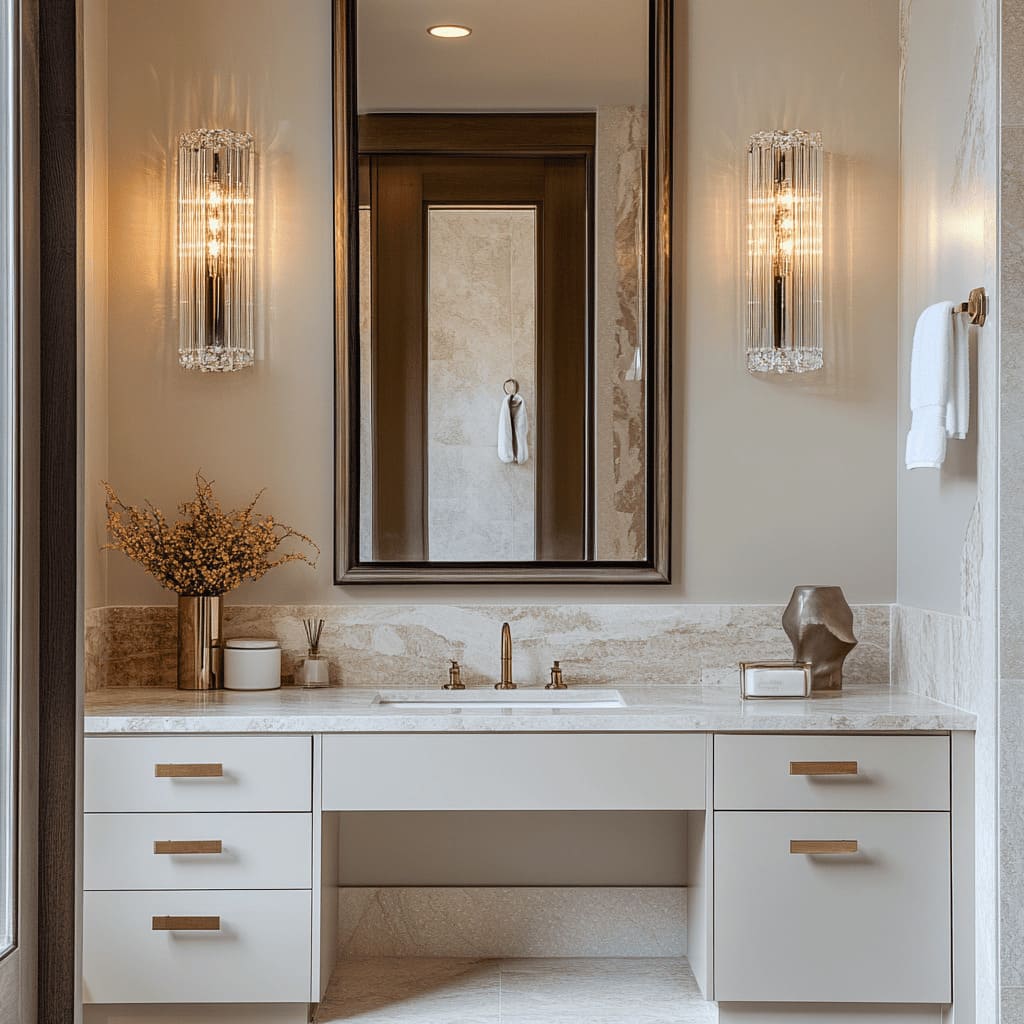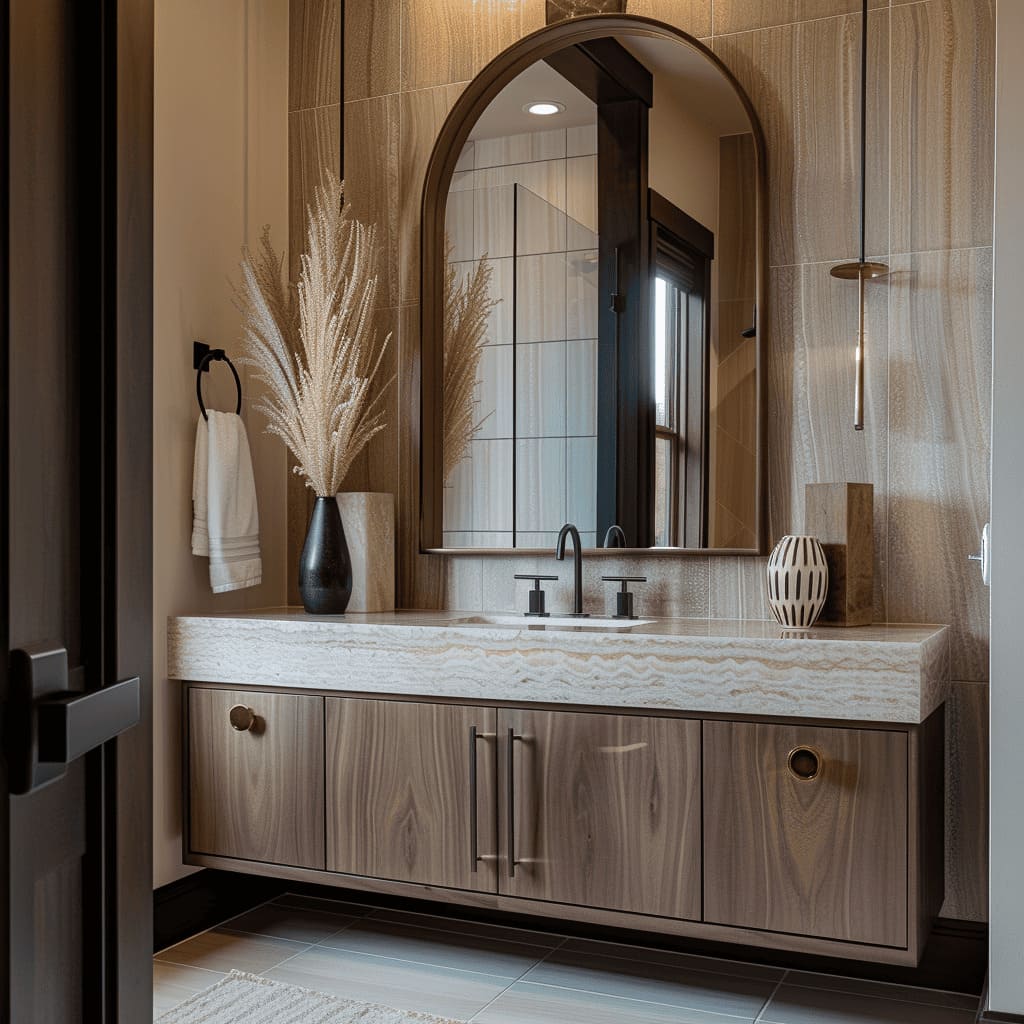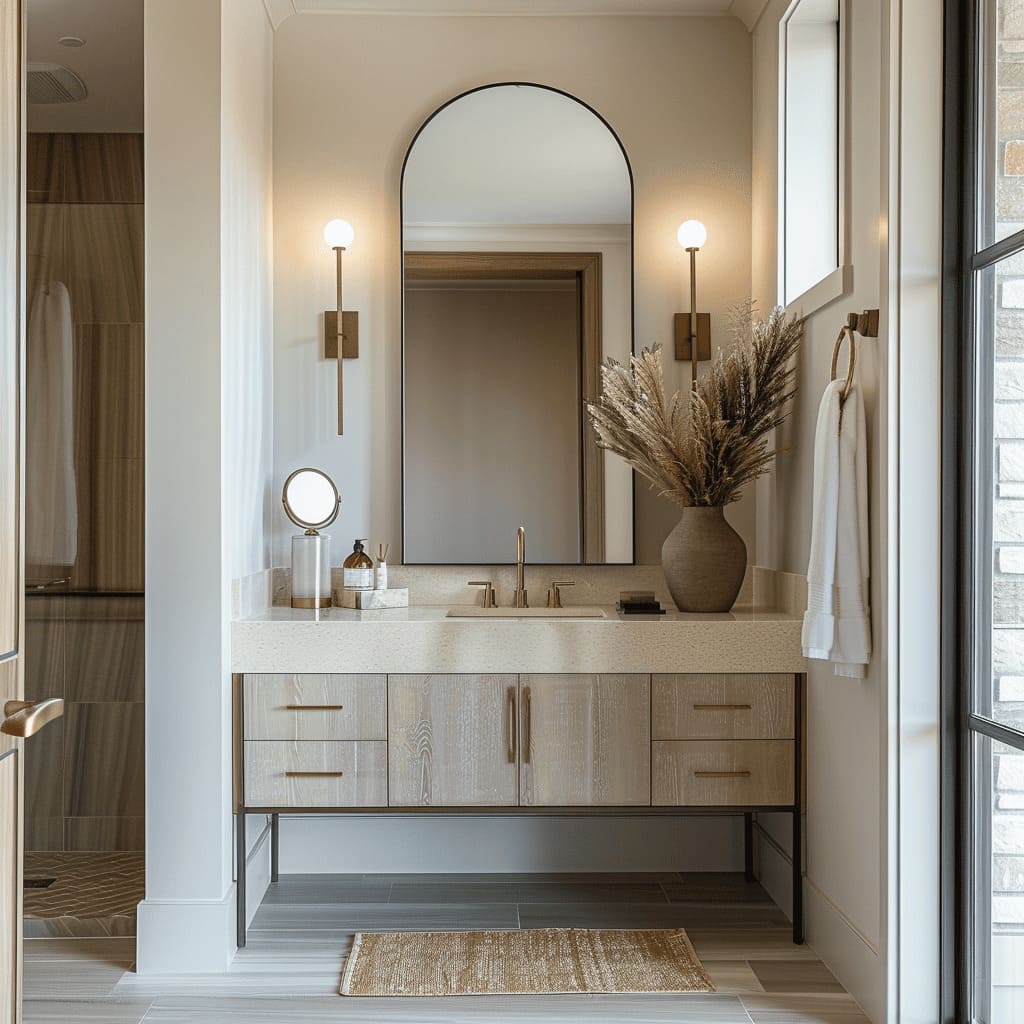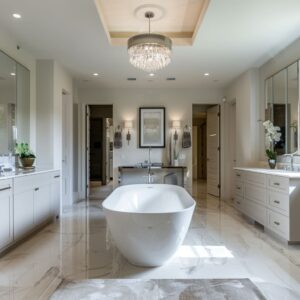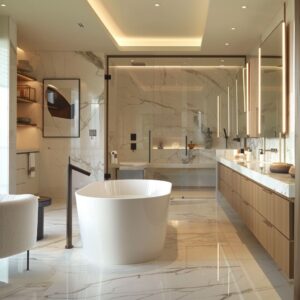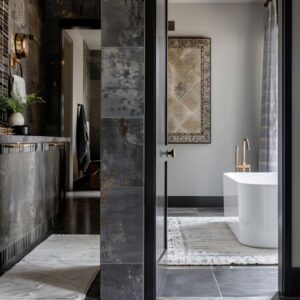Transitional bathroom vanities have become a significant trend in modern home design, offering a sophisticated blend of different styles. This design approach combines the sleek lines of contemporary decor with the timeless appeal of vintage elements and the minimalistic charm of Scandinavian aesthetics.
The result is a versatile and adaptable style that works well in various bathroom settings. This article will explore how to effectively merge these three distinct styles into a cohesive transitional bathroom vanity, examining aspects such as material choices, color palettes, design elements, and the thoughtful incorporation of decor and accessories.
By the end of this piece, you will have a comprehensive understanding of creating a bathroom vanity that captures the essence of transitional design
Understanding the Transitional Bathroom Vanity Style
Definition and Key Characteristics
A transitional bathroom vanity embodies a harmonious blend of contemporary, vintage, and Scandinavian styles. This design is characterized by its ability to balance clean lines and minimalism with the warmth and character of more traditional elements
The contemporary aspect of transitional design focuses on sleek, streamlined shapes and modern finishes, while the vintage influence adds intricate detailing, such as decorative moldings and classic hardware. Meanwhile, the Scandinavian influence brings a sense of simplicity, functionality, and a connection to natural elements, often seen in the use of light woods and soft color palettes.
This blend creates a versatile style that can be both relaxed and refined, making it suitable for various bathroom settings.
Historical Context
The transitional style in interior design emerged as a response to the desire for a more balanced and flexible aesthetic. It evolved from a need to bridge the gap between the ornate, heavily decorated styles of the past and the stark, often cold, minimalism of modern design.
The introduction of Scandinavian elements into this mix further softened the look, bringing a sense of calm and a focus on natural materials. This style has grown in popularity due to its ability to combine the best of different design worlds, allowing homeowners to create spaces that feel both familiar and fresh, offering a perfect middle ground between the old and the new
Materials and Finishes
Wood and Cabinetry Choices
Wood is a foundational material in transitional bathroom vanities, contributing both aesthetic value and practical benefits. High-quality woods such as walnut and oak are frequently used, chosen for their durability and beautiful grain patterns.
These woods often have a warm finish that highlights their natural texture, adding depth and character to the vanity
The choice of wood plays a crucial role in achieving the desired balance of contemporary and vintage styles. Light finishes, like those found in Scandinavian designs, provide a sense of openness and airiness, while darker, richer tones can introduce a touch of classic elegance.
The key is to select wood finishes that complement the overall color palette and contribute to a unified look
Countertop and Backsplash Materials
Countertops and backsplashes are integral to the design of a transitional vanity, serving both functional and decorative purposes. Materials such as polished marble, onyx, and quartz are popular choices due to their durability and luxurious appearance.
Polished marble, with its creamy tones and subtle veining, adds a sense of understated luxury and complements both modern and vintage elements
Onyx, known for its dramatic veining and translucent qualities, can serve as a statement piece, adding depth and interest to the vanity. Quartz offers a more contemporary feel with its clean, uniform appearance and is often chosen for its practicality and resistance to stains and scratches.
The choice of stone should align with the overall aesthetic, providing a cohesive element that ties the vanity together
Hardware and Fixtures
Hardware and fixtures are the finishing touches that can make or break a transitional vanity design. Brushed brass, polished nickel, and matte black finishes are all popular choices that can enhance the look of a vanity.
Brushed brass and polished nickel add a hint of vintage charm, while matte black offers a contemporary, industrial feel.
The choice of hardware should complement the wood and countertop materials, providing a cohesive look that ties all the elements together. Fixtures such as faucets and handles should be simple yet elegant, with clean lines that reflect the minimalist approach of contemporary and Scandinavian styles, while still offering a nod to the more ornate details of vintage design
Design Elements of Transitional Bathroom Vanities
Floating Vanity Designs
Floating vanities are a hallmark of contemporary design, and they work beautifully within a transitional context. By mounting the vanity to the wall and leaving space beneath, the design feels lighter and more open
This approach is especially effective in smaller bathrooms, where maximizing space is essential. Floating vanities also provide an opportunity to showcase beautiful flooring, further enhancing the room’s aesthetic.
The minimalist look of a floating vanity is balanced by the warmth of natural wood or the texture of stone countertops, creating a design that feels both modern and grounded
Integrated and Vessel Sinks
Sinks play a crucial role in defining the style of a transitional vanity. Integrated sinks, which are seamlessly built into the countertop, offer a sleek, modern look that emphasizes clean lines and simplicity.
They are easy to maintain and provide a smooth, uninterrupted surface that enhances the contemporary feel of the vanity.
On the other hand, vessel sinks, which sit atop the countertop, can introduce a vintage or rustic touch, depending on their shape and material. A round, ceramic vessel sink, for instance, can add a softer, more organic element to the vanity, balancing the harder lines of a contemporary design.
The choice between an integrated or vessel sink should be guided by the overall aesthetic and functional needs of the bathroom
Mirrors and Reflections
Mirrors are more than just functional elements in a bathroom; they are also key design components that can significantly impact the room’s aesthetic. In a transitional bathroom, mirrors often feature unique shapes and frames that blend contemporary and vintage styles.
Arched or scalloped mirrors, for instance, add a touch of elegance and sophistication, while maintaining a modern edge. The frames can be finished in brushed metal or matte black, complementing the hardware and fixtures of the vanity.
Mirrors also enhance the sense of space and light, making the bathroom feel larger and more inviting
See How Far Your Budget Can Go for a Bathroom Makeover
Not sure what you can afford with your current budget? Whether you’re looking for a minor refresh or a complete overhaul to achieve a trendy farmhouse style with natural wood accents, our calculator will give you a clear picture of your options.
[budget_renovation_calculator]
Lighting and Ambiance
Wall Sconces and Pendant Lighting
Lighting is a crucial element in creating the right ambiance in a transitional bathroom. Wall sconces and pendant lights are popular choices, providing both task lighting and a decorative touch.
Wall sconces with brushed brass or matte black finishes can enhance the vintage or contemporary elements of the vanity, while clear or frosted glass shades soften the light and create a warm, inviting glow
Pendant lights add a touch of modern sophistication, with sleek, minimalist designs that draw the eye upward, enhancing the room’s vertical space. The placement of lighting should be carefully considered to ensure that it illuminates the vanity effectively while also contributing to the overall aesthetic
Chandeliers and Decorative Fixtures
For those looking to add a touch of luxury and drama to their transitional bathroom, a chandelier or decorative light fixture can make a stunning statement. Crystal chandeliers, with their sparkling prisms and intricate designs, add a touch of old-world glamour, contrasting beautifully with the clean lines of a contemporary vanity.
Alternatively, a more modern fixture with geometric shapes or exposed bulbs can reinforce the contemporary elements of the space while still offering a nod to vintage styles. The key is to choose a fixture that complements the overall design without overpowering it, creating a harmonious blend of styles
Color Palette and Textures
Neutral and Warm Tones
The color palette of a transitional bathroom vanity often revolves around neutral and warm tones, creating a calming and cohesive environment. Shades of beige, taupe, and cream are commonly used, providing a soft backdrop that allows the more striking elements, such as hardware and fixtures, to stand out.
These colors are versatile and timeless, offering a sense of comfort and relaxation. The use of warm tones in the wood and stone materials further enhances this feeling, creating a space that feels both welcoming and refined
Contrasting Elements
Incorporating contrasting elements is key to achieving a balanced transitional design. Dark accents, such as matte black hardware or fixtures, provide a striking contrast against lighter cabinetry and countertops, adding depth and interest to the vanity.
These darker elements can also serve to ground the design, creating a focal point that draws the eye. Textures also play an important role in creating contrast, with smooth, polished surfaces like marble or onyx offset by the natural grain of wood or the rough texture of a woven basket.
The interplay of light and dark, smooth and textured, creates a dynamic and visually engaging space
Decor and Accessories
Natural Elements and Organic Decor
Bringing natural elements into a transitional bathroom vanity design adds warmth and texture, enhancing the overall aesthetic. Dried pampas grass, wicker baskets, and ceramic vases are popular choices for adding an organic touch.
These elements introduce a sense of nature into the bathroom, complementing the wood and stone materials of the vanity
The use of natural decor also aligns with the Scandinavian influence in transitional design, which emphasizes simplicity, functionality, and a connection to the outdoors. Placing a tall vase with dried grasses on the vanity countertop, for example, can add height and texture, creating a focal point that draws the eye and adds visual interest
Functional Yet Aesthetic Accessories
Accessories in a transitional bathroom should be both functional and aesthetically pleasing. Items such as soap dispensers, towels, and trays should complement the vanity’s design while serving a practical purpose.
For example, a soap dispenser in a brushed brass finish can add a touch of vintage charm while coordinating with the faucet and hardware. Similarly, a neatly folded towel on a matte black towel ring adds a simple, clean element that enhances the overall look of the vanity.
The goal is to select accessories that enhance the design without overwhelming it, creating a cohesive and harmonious space
Floor and Wall Treatments
Flooring Options
Flooring is an important element in a transitional bathroom, providing both a foundation for the design and a surface that must withstand daily use. Large-format porcelain tiles that mimic the look of natural stone or wood are popular choices, offering durability and ease of maintenance.
These tiles come in a variety of colors and finishes, allowing for a customized look that complements the vanity and overall bathroom design. Laying the tiles in a linear pattern can enhance the sense of space and add a modern touch, while a more traditional layout, such as a herringbone or chevron pattern, can introduce a vintage element
Wall Treatments and Textures
Wall treatments in a transitional bathroom often feature a combination of textures and materials that add depth and interest to the space. Wood-look tiles and wainscoting are popular choices, providing a natural, rustic touch that complements the contemporary and vintage elements of the vanity.
These treatments can be used to create a feature wall behind the vanity, adding a focal point that enhances the overall design. The use of different textures, such as smooth marble and rough wood, creates a dynamic and engaging space that feels both modern and timeless
Creating a Cohesive Transitional Bathroom Vanity
Balancing Contemporary, Vintage, and Scandinavian Elements
Achieving the right balance between contemporary, vintage, and Scandinavian styles is key to creating a successful transitional bathroom vanity. The goal is to blend these elements in a way that feels natural and cohesive, rather than forced or disjointed.
This can be achieved by carefully selecting materials, finishes, and accessories that complement each other and enhance the overall design. For example, pairing a sleek, modern vanity with vintage-inspired hardware and Scandinavian-style decor can create a harmonious look that is both stylish and functional
Practical Considerations
In addition to aesthetic considerations, it is important to think about the practical aspects of designing a transitional bathroom vanity. Storage solutions, space planning, and ease of maintenance are all important factors to consider.
The vanity should provide ample storage for bathroom essentials, while also maintaining a clean and uncluttered appearance
The choice of materials should be both beautiful and durable, able to withstand the rigors of daily use. By carefully considering these practical aspects, you can create a bathroom vanity that is both stylish and functional, offering a perfect blend of form and function
Planning a bathroom refresh but unsure of the budget? Our remodel cost calculator can give you a better idea of the costs involved.
Just input your details, and you’ll receive a tailored estimate to help you make informed decisions about your renovation project!
Conclusion
In conclusion, a transitional bathroom vanity offers a unique and versatile design option that combines the best of contemporary, vintage, and Scandinavian styles. By carefully selecting materials, finishes, and accessories, and by balancing these different design elements, you can create a bathroom vanity that is both stylish and functional.

